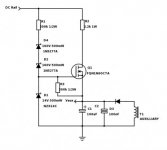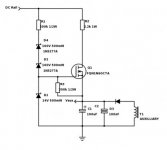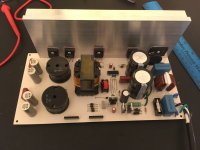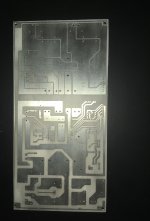Silvio
Well-known member
Correction
According to my schematic regarding the constant current source in 350w smps based on borysgo2 here is a better explanation so that you can better understand how it works.
1) Thermister limiting inrush current starts charging bulk caps. Now TR1 is biased via R1, ZD1 and ZD2 this will stabilize the voltage on the collector to 170v via R2
(R2 can be reduced to 33k)and also will drive the base of TR2 to 10v. As TR2 collector is in series with R2 current is limited to around 5mA This was enough to supply the IR 2153 chip however if more current is needed you can change the transistors like MJE340 and reduce the value of R2 to give more power to TR2. Now TR2 starts charging C3 until the trigger voltage for the SG3525 (8v) is reached however in my case it was 10uf and the reason for this was as the current limiter was shunting the supply rail to ground when it operates and this had to be done quickly discharging also C3 in the process. In your case you can add more capacitance here and more time will be added before trigger voltage is reached so you see at 170v will be enough and in the mean time C3 is charging, the bulk caps will continue as well and their voltage will rise near the peak before oscillation commences. However more capacitance in C3 gives more current at start up. You can always simulate it on LT SPICE and see the result
Regards
Silvio
According to my schematic regarding the constant current source in 350w smps based on borysgo2 here is a better explanation so that you can better understand how it works.
1) Thermister limiting inrush current starts charging bulk caps. Now TR1 is biased via R1, ZD1 and ZD2 this will stabilize the voltage on the collector to 170v via R2
(R2 can be reduced to 33k)and also will drive the base of TR2 to 10v. As TR2 collector is in series with R2 current is limited to around 5mA This was enough to supply the IR 2153 chip however if more current is needed you can change the transistors like MJE340 and reduce the value of R2 to give more power to TR2. Now TR2 starts charging C3 until the trigger voltage for the SG3525 (8v) is reached however in my case it was 10uf and the reason for this was as the current limiter was shunting the supply rail to ground when it operates and this had to be done quickly discharging also C3 in the process. In your case you can add more capacitance here and more time will be added before trigger voltage is reached so you see at 170v will be enough and in the mean time C3 is charging, the bulk caps will continue as well and their voltage will rise near the peak before oscillation commences. However more capacitance in C3 gives more current at start up. You can always simulate it on LT SPICE and see the result
Regards
Silvio




